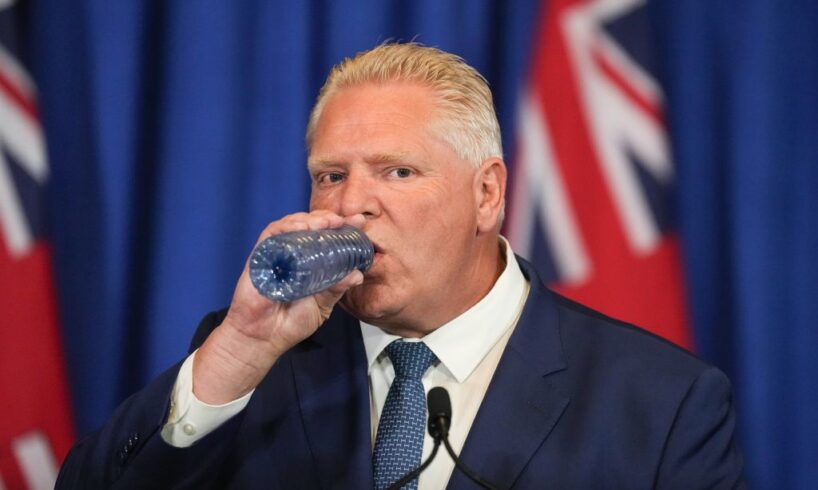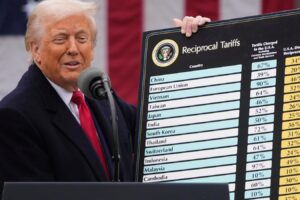
The Doug Ford government wants to give itself the power to dictate more of the rules around how Ontario protects its drinking water.
The Ministry of Red Tape Reduction said the process in place to change the rules around drinking water is “overly complex and slow.” It said reforming that process will support housing construction and development, while keeping water safeguards in place.
But one expert said the move will take away power from local committees tasked with protecting their region’s water supply, centralizing it in the hands of the government.
If the government wants to beef up some local water protections, some tweaks to the process could be useful, according to Theresa McClenaghan, executive director of the Canadian Environmental Law Association. But without more details from the government clarifying how it will use its new powers, she added, it could also open the door to weaker public health protections down the road.
That’s a particularly ominous thought for some, coming 25 years after the Walkerton tragedy, which killed seven people and caused 2,300 more to become seriously ill, when the water supply in the town on the east side of Lake Huron became contaminated with E. coli from cattle manure.
Ontario Green Party leader Mike Schreiner said the changes amount to “reducing the power of independent, evidence-based experts and transferring that authority to the minister.”
“It certainly weakens the protections that were put in place out of the lessons learned from Walkerton,” he said in an interview. That includes the need for overlapping layers of protection.
Ontario’s Environment Ministry doesn’t have the capacity to regularly inspect all of the non-municipal drinking water systems it regulates, the province’s Auditor General has found. Many current protections were put in place after thousands became sick from contaminated water in Walkerton, Ont., near Lake Huron. Photo: Carlos Osorio / The Narwhal
“In the same way that we have a lot of redundancies around air traffic control … if something goes wrong here, you want to make sure there are other checks and balances. Because once you contaminate drinking water, you put people’s lives at risk.”
Red Tape Reduction Minister Andrea Khanjin’s office did not respond to questions from The Narwhal before publication.
Green Party: Walkerton showed the need for multiple levels of Ontario drinking water protection
On Oct. 20, Premier Ford’s Progressive Conservative government introduced Bill 56, the Building a More Competitive Economy Act. Among other things, the bill would change the Clean Water Act, a law put in place following a two-year inquiry into the disaster in Walkerton.
The Walkerton inquiry found the incident could have been prevented if a local official had properly monitored drinking water treatments — and if the Progressive Conservative government of the time, under Mike Harris, had not cut funding to the provincial Environment Ministry.
One solution that came out of the inquiry was to establish a series of regional plans to protect Ontario’s sources of drinking water.
The plans are locally developed and overseen by conservationists, public representatives and others. They identify groundwater and surface water flows around local drinking water supplies, the risks posed by things like industrial pollution or agricultural runoff and what rules should be in place to mitigate those risks.
There are now 19 committees overseeing 38 of these water protection plans across the province. The area each plan oversees is based largely on the conservation authorities in Ontario, along with two others that apply to areas of Georgian Bay and the Bruce Peninsula, and are tailored to the geology and hydrology of each area.
McClenaghan, of the Canadian Environmental Law Association, said the point of this decentralized system is to make sure that each region has practical rules that make sense for them, including for local businesses.
The Building a More Competitive Economy Act would change the law so the government can dictate more of the specific wording around drinking water rules in the protection plans, instead of leaving that to the committees, she said.
For example, the province could mandate standardized wording to ban animal manure from certain zones around water wells, the cause of the Walkerton tragedy, instead of letting the local committee describe that as it chooses, she said.
“Basically, from what I can see, it’s just substituting the current system with a more prescriptive approach,” she said.
“It will remove some flexibility and approach from the committees — and I’ll be quite keen to find out from committees if they think some of their current approaches wouldn’t be permitted.”
The province might also step in to block a water protection committee’s specific approach to dealing with a threat to its local water supply, McClenaghan said. But she added Ontarians won’t know specific details until the government clarifies its role. That won’t happen until the Building a More Competitive Economy Act, which is being debated in the legislature, is passed.
Schreiner said one of the lessons from Walkerton was the need to have a “multi-barrier approach” and the committees were set up “to take the politics out of it.”
Having a multi-step system in place to ensure companies can’t carry out activities with a high risk of contamination, he said, may have prevented the extent of the mercury poisoning that happened in Grassy Narrows First Nation, where drinking water has been contaminated for decades.
In a press release, the government said it wants to change the clean water law because current requirements like consultation periods and ministerial approval can take years for even “routine” projects with pre-defined protections, like replacing an existing well.
It said it would be “simplifying consultation” and “expanding what counts as a minor change” to the water protection plans. This would support “housing and infrastructure development,” the government claimed, while keeping “strong protections for source water in place” as well as “timely, effective safeguards for municipal drinking water sources.”
The changes are “streamlining” so that “unnecessary repetition” is avoided, Environment Minister Todd McCarthy told reporters the day the bill was introduced.
Ford plans to change both Clean Water Act and Safe Drinking Water Act
The government also said there would be upcoming changes to the Safe Drinking Water Act — a separate law that makes sure tap water can be consumed and establishes rules around water treatment — that would let new wells or intakes start supplying water while the protection plans were still being updated.
The Ontario government recently announced plans to change the Clean Water Act to support “housing and infrastructure development” while keeping “strong protections for source water in place.” Photo: Christopher Katsarov Luna / The Narwhal
The Building a More Competitive Economy Act is not the first time the Ford government has enacted laws that may jeopardize the province’s drinking water protections, according to McClenaghan’s organization.
In a blog post from April, the Canadian Environmental Law Association said the two-year-old Helping Homebuyers, Protecting Tenants Act, that allowed municipalities to more easily sprawl, could allow the use of ministerial zoning orders to bypass some drinking water protection rules.
And it said the More Homes Built Faster Act, introduced the year prior under Bill 23, limited the power of conservation authorities to stop developments that could harm water sources.
Ontario’s Auditor General released a report in March which found the Ministry of the Environment, Conservation and Parks doesn’t have the capacity to regularly inspect all 1,816 non-municipal drinking water systems it regulates.
Some communities in Ontario, like Six Nations of the Grand River, still do not have safe drinking water at all.
Meanwhile, the Ford government called on the federal government earlier this year not to entrench the right to clean drinking water in law.





